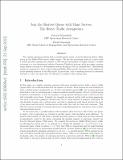| dc.contributor.author | Eschenfeldt, Patrick Clark | |
| dc.contributor.author | Gamarnik, David | |
| dc.date.accessioned | 2019-03-13T14:16:24Z | |
| dc.date.available | 2019-03-13T14:16:24Z | |
| dc.date.issued | 2018-02 | |
| dc.identifier.issn | 0364-765X | |
| dc.identifier.issn | 1526-5471 | |
| dc.identifier.uri | http://hdl.handle.net/1721.1/120946 | |
| dc.description.abstract | We consider queueing systems with n parallel queues under a Join the Shortest Queue (JSQ) policy in the Halfin-Whitt heavy-traffic regime. We use the martingale method to prove that a scaled process counting the number of idle servers and queues of length exactly two weakly converges to a two-dimensional reflected Ornstein-Uhlenbeck process, while processes counting longer queues converge to a deterministic system decaying to zero in constant time. This limiting system is comparable to that of the traditional Halfin-Whitt model, but there are key differences in the queueing behavior of the JSQ model. In particular, only a vanishing fraction of customers will have to wait, but those who do incur a constant order waiting time. Keywords: queueing theory; parallel queues; diffusion models | en_US |
| dc.publisher | Institute for Operations Research and the Management Sciences (INFORMS) | en_US |
| dc.relation.isversionof | http://dx.doi.org/10.1287/MOOR.2017.0887 | en_US |
| dc.rights | Creative Commons Attribution-Noncommercial-Share Alike | en_US |
| dc.rights.uri | http://creativecommons.org/licenses/by-nc-sa/4.0/ | en_US |
| dc.source | arXiv | en_US |
| dc.title | Join the Shortest Queue with Many Servers. The Heavy-Traffic Asymptotics | en_US |
| dc.type | Article | en_US |
| dc.identifier.citation | Eschenfeldt, Patrick and David Gamarnik. “Join the Shortest Queue with Many Servers. The Heavy-Traffic Asymptotics.” Mathematics of Operations Research 43, 3 (August 2018): 867–886 © 2018 INFORMS | en_US |
| dc.contributor.department | Massachusetts Institute of Technology. Operations Research Center | en_US |
| dc.contributor.department | Sloan School of Management | en_US |
| dc.contributor.mitauthor | Eschenfeldt, Patrick Clark | |
| dc.contributor.mitauthor | Gamarnik, David | |
| dc.relation.journal | Mathematics of Operations Research | en_US |
| dc.eprint.version | Original manuscript | en_US |
| dc.type.uri | http://purl.org/eprint/type/JournalArticle | en_US |
| eprint.status | http://purl.org/eprint/status/NonPeerReviewed | en_US |
| dc.date.updated | 2019-02-13T17:59:33Z | |
| dspace.orderedauthors | Eschenfeldt, Patrick; Gamarnik, David | en_US |
| dspace.embargo.terms | N | en_US |
| dc.identifier.orcid | https://orcid.org/0000-0003-4865-7645 | |
| dc.identifier.orcid | https://orcid.org/0000-0001-8898-8778 | |
| mit.license | OPEN_ACCESS_POLICY | en_US |
